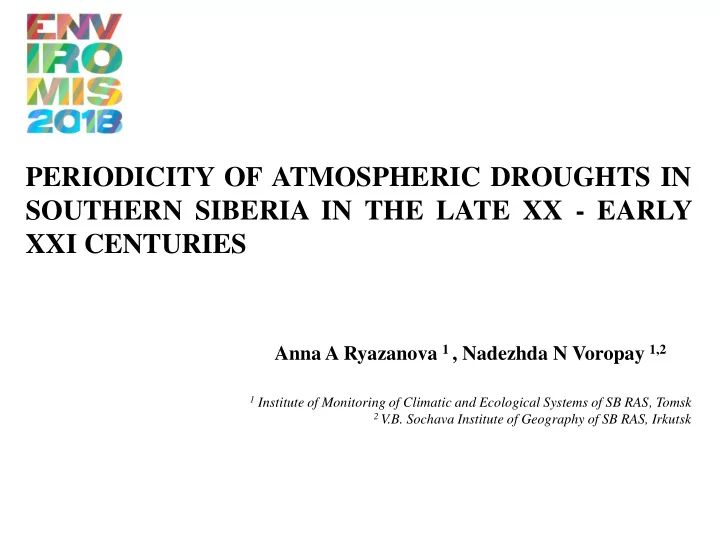

PERIODICITY OF ATMOSPHERIC DROUGHTS IN SOUTHERN SIBERIA IN THE LATE XX - EARLY XXI CENTURIES Anna A Ryazanova 1 , Nadezhda N Voropay 1,2 1 Institute of Monitoring of Climatic and Ecological Systems of SB RAS, Tomsk 2 V.B. Sochava Institute of Geography of SB RAS, Irkutsk
Introduction Modern global climate changes are characterized by a significant warming in the end of XX – beginning of XXI centuries (starting from the second part of 1970s). A drought is a complex natural phenomenon with strong regional anomalies of temperature and humidification. There are many different studies about droughts: • their detection; • determination of their characteristic types; • forming condition; • development of the most representative aridity indices; • catastrophic droughts analysis • Etc. IPCC, 2014: Climate Change 2014: Synthesis Report. 2
To detect droughts, we used: Ped drought index (S) – normalized ratio of air temperature and precipitation:: 𝑻 𝒋 = ∆𝑼 𝒋 − ∆𝑸 𝒋 , 𝝉 𝑼 𝝉 𝑸 ∆𝑈 𝑗 = 𝑈 𝑗 − 𝑈 𝑜𝑝𝑠𝑛 - temperature anomaly in the i-th period, 𝜏 𝑈 - standard deviation of temperature. For the precipitation is the similar. Intensity of drought Ped index(S) 1 ≤ S i < 2 Norm 2 ≤ S i < 3 Moderate 3 ≤ S i < 4 Severe S i ≥ 4 Extreme 3
Territory, data and time interval of investigation ▪ Southern Siberia (50-65 ° N, 60-120 ° E). ▪ May-September from 1979 to 2017 years. ▪ Air temperature and precipitation data: Corrected ERA-Interim reanalysis (0.75 × 0.75 ° grid) by the weather stations Station with homogeneous series of observations (107) Station with non-homogeneous series of observations (46) 4
Dedicated software: The system "CLIMATE", based on web- and GIS-techniques, is a part of a hardware and software complex for "cloud" analysis of climate data. 5
1979 - 2017 years Frequency of droughts, % Extreme Severe Moderate Norm May 60 ° N Jun 60 ° N Jul 60 ° N Aug 60 ° N Sep 60 ° N 90 ° E 90 ° E 90 ° E 90 ° E 6
Number of droughts in May Extreme Severe 1979- 60 ° N 1989 1990- 60 ° N 2000 2001- 60 ° N 2017 90 ° E 90 ° E Duration of dry month (S > 1) 2001 2002 2012 60 ° N 60 ° N 60 ° N 90 ° E 90 ° E 90 ° E 7
Conclusion • The trends of the droughts index in the summer months are different, and on the average, there has been no significant change in the hydrothermal conditions over the past 40 years • In recent years the duration of dry periods and frequency of droughts during the growing season has been increased. 8
Thank you for attention! 9
Recommend
More recommend